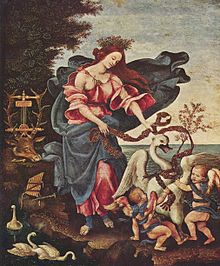Allegory

Allegory is a figurative mode of representation conveying meaning other than the literal. Allegory communicates its message by means of symbolic figures, actions or symbolic representation. Allegory is generally treated as a figure of rhetoric, but an allegory does not have to be expressed in language: it may be addressed to the eye, and is often found in realistic painting, sculpture or some other form of mimetic, or representative art. Simply put, an allegory is a device that can be presented in literary form, such as a poem or novel, or in visual form, such as in painting or sculpture. As a literary device, an allegory in its most general sense is an extended metaphor. As an artistic device, an allegory is a visual symbolic representation. An example of a simple visual allegory is the image of the grim reaper. Viewers understand that the image of the grim reaper is a symbolic representation of death. Nevertheless, images and fictions with several possible interpretations are not allegories in the true sense. Furthermore, not every fiction with general application is an allegory.
Etymology
First coined in English 1382, the word "allegory" comes from Latin "allegoria", the latinisation of the Greek "ἀλληγορία" (allegoria), "veiled language, figurative",[1] from "ἄλλος" (allos), "another, different"[2] + "ἀγορεύω" (agoreuo), "to harangue, to speak in the assembly"[3] and that from "ἀγορά" (agora), "assembly".[4]
Allegory
Northrop Frye discussed what he termed a "continuum of allegory", ranging from what he termed the "naive allegory" of The Faerie Queene, to the more private allegories of modern paradox literature. In this perspective, the characters in a "naive" allegory are not fully three-dimensional, for each aspect of their individual personalities and the events that befall them embodies some moral quality or other abstraction; the allegory has been selected first, and the details merely flesh it out.
Many ancient religions are based on an astrologic allegories, that is, allegories of the movement of the Sun and the Moon as seen from the Earth. Examples include the cult of Horus/Isis.
The classical era
In classical literature two of the best-known allegories are the cave in Plato's Republic (Book VII) and the story of the stomach and its members in the speech of Menenius Agrippa (Livy ii. 32). In Late Antiquity Martianus Capella organized all the information a fifth-century upper-class male needed to know into an allegory of the wedding of Mercury and Philologia, with the seven liberal arts as guests; Capella's allegory was widely read through the Middle Ages.
Other early allegories are found in the Hebrew Bible, for instance in the extended metaphor in Psalm 80 of the Vine, which is Israel[5] and Ezekiel 16 and 17.[6]
The medieval era
Medieval thinking accepted allegory as having a reality underlying any rhetorical or fictional uses. The allegory was as true as the facts of surface appearances. Thus, the bull Unam Sanctam (1302) presents themes of the unity of Christendom with the pope as its head in which the allegorical details of the metaphors are adduced as actual facts on which is based a demonstration with the vocabulary of logic: "Therefore of this one and only Church there is one body and one head—not two heads as if it were a monster... If, then, the Greeks or others say that they were not committed to the care of Peter and his successors, they necessarily confess that they are not of the sheep of Christ" (complete text).
In the late fifteenth century, the enigmatic Hypnerotomachia, with its elaborate woodcut illustrations, shows the influence of themed pageants and masques on contemporary allegorical representation, as humanist dialectic conveyed them.
The denial of medieval allegory as found in the eleventh-century works of Hugh of St Victor and Edward Topsell's Historie of Foure-footed Beastes (London, 1607, 1653) and its replacement in the study of nature with methods of categorization and mathematics by such figures as naturalist John Ray and the astronomer Galileo is thought to mark the beginnings of early modern science.[7]
The modern era
Since meaningful stories are nearly always applicable to larger issues, allegories may be read into many stories, sometimes distorting their author's overt meaning. For instance, many people have suggested that The Lord of the Rings is an allegory for the World Wars, in spite of J. R. R. Tolkien's emphatic statement in the introduction to the second edition, "It is neither allegorical nor topical....I cordially dislike allegory in all its manifestations, and always have done so since I grew old and wary enough to detect its presence."
Where some requirements of "realism", in its flexible meanings, are set aside, allegory can come more strongly to the surface, as in the work of Bertold Brecht or Franz Kafka on one hand, or on the other in science fiction and fantasy, where an element of universal application and allegorical overtones are common, as with Dune.
Not every work of fiction is an allegory. Arthur Miller's The Crucible is character-driven historical drama with contemporary relevance, but is not an allegory. Admittedly, however, this text can (and often is) read as an allegory for McCarthyism; linking the hunt for communists in the 1940's and '50s to the hunt for witches in the late 1600s. L. Frank Baum's The Wonderful Wizard of Oz is plot-driven fantasy narrative in an extended fable with talking animals and broadly-sketched characters. It has been read as an allegory for the political problems of the time; however, it (as mentioned above with Tolkien's work) is possible that such allegory was read in after the fact.
List of allegorical works by genre
Art



Some elaborate and successful specimens of allegory are to be found in the following works, arranged in approximate chronological order:
- Ambrogio Lorenzetti; "Good Government in the City" and "Bad Government in the City"
- Sandro Botticelli – La Primavera (Allegory of Spring)
- Albrecht Dürer – Melencolia I
- Bronzino – Venus, Cupid, Folly, and Time
- Artemisia Gentileschi – Self-Portrait as the Allegory of Painting; Allegory of Inclination
- The English School's "Allegory of Queen Elizabeth" painted circa 1610.
- Jan Vermeer – The Allegory of Painting
- Irene Alexandra Guerihael, "Aletheia", "Architects of Future"
Literature
Literature of the classical era
- Aesop – Fables
- Plato – The Republic ("Plato's allegory of the cave")
- Plato – Phaedrus (Chariot Allegory)
- Euripides – The Trojan Women
- Qu Yuan – Encountering Trouble
- Book of Revelation (for allegory in Christian theology, see typology (theology))
- Martianus Capella – De nuptiis philologiæ et Mercurii
Literature of mediaeval era
- Prudentius – Psychomachia
- Christine de Pizan – The Book of the City of Ladies
- William Langland – Piers Plowman
- Pearl
- Dante Alighieri – The Divine Comedy
- Everyman
- Edmund Spenser – The Faerie Queene
Literature of modern era
- Jorge Luis Borges – "The Library of Babel" and "The Babylon Lottery"
- Peter S. Beagle – The Last Unicorn
- William M. Burwell – White Acre vs. Black Acre
- Albert Camus – The Plague, The Stranger, and Myth of Sisyphus
- John Irving – A Prayer for Owen Meany
- David Lindsay – A Voyage to Arcturus
- Naguib Mahfouz – Children of Gebelawi
- Hualing Nieh – Mulberry and Peach
- Herman Melville – Moby Dick
- George Orwell – Animal Farm
- Philip Pullman – His Dark Materials
- Rex Warner – The Aerodrome
- J. D. Salinger – The Catcher in the Rye
- J.M. Coetzee – Waiting for the Barbarians
- Cormac McCarthy – The Road
- George MacDonald – Phantastes
- Wu Cheng'en — The Journey to the West
- John Bunyan – Pilgrim's Progress
- Anna Sewell – Black Beauty
- Jonathan Swift – A Tale of a Tub
- Joseph Addison – Vision of Mirza
- E. T. A. Hoffmann – Princess Brambilla
- Nathaniel Hawthorne – "The Great Carbuncle", "Young Goodman Brown"
- Herman Melville – The Confidence-Man
- Edgar Allan Poe – "The Masque of the Red Death" (though Poe did not believe in allegory, this story is generally assumed to be one)[8]
- C.S. Lewis – The Chronicles of Narnia: generic allegorical elements of good and evil, as well as many Christian themes, expressed in a narrative with strong fantasy fiction elements and credible characters: not fully an allegory.
- William Golding – Lord of the Flies
- Charles Dickens – A Christmas Carol
- Bernard Malamud – The Natural
Film
- Fritz Lang's Metropolis
- Ingmar Bergman's The Seventh Seal
- El Topo
- Star Trek: The Undiscovered Country, the Cold War
- The Matrix
- The Virgin Suicides
- District 9, Apartheid
- Gojira
- Foodland (film)
- The Wall (film)
Television
- The Twilight Zone (varied themes)
- Star Trek all series, (varied themes, though frequently addressed the issues of prejudice and racism)
- The Prisoner
Comics
- various X-Men comics (mutants as an allegory for racial minorities)
See also
- Allegory in the Middle Ages
- Allegory in Renaissance literature
- Allegorical sculpture
- Cultural depictions of Philip II of Spain
- Literary technique
- Plot device
- Roman à clef
- Semiotics
References
- ^ ἀλληγορία, Henry George Liddell, Robert Scott, A Greek-English Lexicon, on Perseus Digital Library
- ^ ἄλλος, Henry George Liddell, Robert Scott, A Greek-English Lexicon, on Perseus Digital Library
- ^ ἀγορεύω, Henry George Liddell, Robert Scott, A Greek-English Lexicon, on Perseus Digital Library
- ^ ἀγορά, Henry George Liddell, Robert Scott, A Greek-English Lexicon, on Perseus Digital Library
- ^ Kennedy, George A. (1999). Classical Rhetoric and Its Christian and Secular Tradition from Ancient to Modern Times (Second ed.). UNC Press. p. 142. ISBN 0-8078-4769-0. Retrieved 2009-08-07.
- ^ Jones, Alexander, ed. (1968). The Jerusalem Bible (Reader's ed.). Doubleday & Company. pp. 1186, 1189. ISBN 0-385-01156-3.
- ^ Peter Harrison, The Bible, Protestantism, and the rise of natural science, Cambridge University Press, ISBN 0-521-59196-1, pages 1 to 10 ("Introduction")
- ^ Roppolo, Joseph Patrick. "Meaning and 'The Masque of the Red Death'", collected in Poe: A Collection of Critical Essays, edited by Robert Regan. Englewood Cliffs, NJ: Prentice-Hall, Inc., 1967. p. 134
Further reading
- Frye, Northrop (1957) Anatomy of Criticism.
- Foucault, Michel (1966) The Order of Things.
External links
- Brief definition of Allegory
- Dictionary of the History of Ideas: Allegory in Literary history
- Electronic Antiquity, Richard Levis, "Allegory and the Eclogues" Roman definitions of allegoria and interpreting Vergil's Eclogues.
